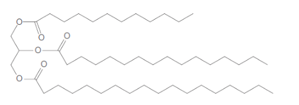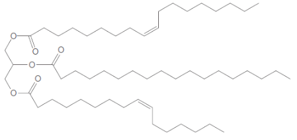
GENERAL,ORGANIC, & BIOLOGICAL CHEM-ACCES
4th Edition
ISBN: 9781265982959
Author: SMITH
Publisher: MCG
expand_more
expand_more
format_list_bulleted
Concept explainers
Textbook Question
Chapter 19, Problem 52P
Draw the products formed when each triacylglycerol is hydrolyzed under each of the following conditions: [1] water and
a. 
b.
Expert Solution & Answer
Want to see the full answer?
Check out a sample textbook solution
Students have asked these similar questions
Don't used hand raiting and don't used Ai solution
Can you explain problems 12-16 for me please. (step by step) and in detail
please solve this question. It is very sensentive with spelling and characters so if it is "no errors" please be specific.
thanks!
Chapter 19 Solutions
GENERAL,ORGANIC, & BIOLOGICAL CHEM-ACCES
Ch. 19.1 - Prob. 19.1PPCh. 19.1 - Prob. 19.1PCh. 19.2 - (a) Draw a skeletal structure for each fatty acid....Ch. 19.2 - Prob. 19.2PCh. 19.2 - Prob. 19.3PCh. 19.3 - Prob. 19.3PPCh. 19.3 - One component of jojoba oil is a wax formed from...Ch. 19.3 - Explain why beeswax is insoluble in water,...Ch. 19.3 - Prob. 19.6PCh. 19.4 - Prob. 19.4PP
Ch. 19.4 - Prob. 19.7PCh. 19.4 - Prob. 19.8PCh. 19.5 - Prob. 19.5PPCh. 19.5 - Review Section 5.2 on balancing chemical...Ch. 19.5 - Prob. 19.10PCh. 19.6 - Prob. 19.6PPCh. 19.6 - Identify the components of each lipid and classify...Ch. 19.7 - Prob. 19.12PCh. 19.7 - Prob. 19.13PCh. 19.7 - Prob. 19.14PCh. 19.8 - (a) Label the rings of the steroid nucleus in...Ch. 19.8 - Prob. 19.16PCh. 19.8 - Prob. 19.17PCh. 19.9 - Prob. 19.18PCh. 19.9 - Prob. 19.19PCh. 19.10 - Prob. 19.20PCh. 19.11 - Prob. 19.21PCh. 19.11 - Prob. 19.22PCh. 19 - Prob. 23PCh. 19 - Prob. 24PCh. 19 - Prob. 25PCh. 19 - Prob. 26PCh. 19 - Prob. 27PCh. 19 - Prob. 28PCh. 19 - Rank the fatty acids in order of increasing...Ch. 19 - Prob. 30PCh. 19 - Prob. 31PCh. 19 - Prob. 32PCh. 19 - Prob. 33PCh. 19 - Prob. 34PCh. 19 - Draw the structure of a wax formed from palmitic...Ch. 19 - Draw the structure of a wax formed from a...Ch. 19 - What hydrolysis products are formed when each wax...Ch. 19 - What hydrolysis products are formed when each wax...Ch. 19 - Prob. 39PCh. 19 - Prob. 40PCh. 19 - Draw a triacylglycerol that fits each description:...Ch. 19 - Draw a triacylglycerol that fits each description:...Ch. 19 - Draw the structure of a triacylglycerol that...Ch. 19 - Draw the structure of a triacylglycerol that...Ch. 19 - Consider the following four types of compounds:...Ch. 19 - How do fats and oils compare with respect to each...Ch. 19 - For the food product shown in the accompanying...Ch. 19 - For the food product shown in the accompanying...Ch. 19 - Answer the following questions about the given...Ch. 19 - Answer the following questions about the given...Ch. 19 - Draw the products formed when each triacylglycerol...Ch. 19 - Draw the products formed when each triacylglycerol...Ch. 19 - Which of the following are phospholipids: (a)...Ch. 19 - Prob. 54PCh. 19 - Prob. 55PCh. 19 - Prob. 56PCh. 19 - wIn transporting molecules or ions across a cell...Ch. 19 - Prob. 58PCh. 19 - Draw the structure of the anabolic steroid...Ch. 19 - Draw the structure of the anabolic steroid...Ch. 19 - Why must cholesterol be transported through the...Ch. 19 - Describe the role of HDLs and LDL5 in cholesterol...Ch. 19 - Prob. 63PCh. 19 - Prob. 64PCh. 19 - (a) Draw the structure of an estrogen and an...Ch. 19 - (a) Draw the structure of an androgen and a...Ch. 19 - What are the similarities and differences between...Ch. 19 - Why aren’t prostaglandins classified as hormones?Ch. 19 - What two structural features characterize all...Ch. 19 - List three biological functions of prostaglandins...Ch. 19 - Explain why aspirin and celecoxib differ in how...Ch. 19 - How does zileuton treat the cause of asthma, not...Ch. 19 - Answer each question with regard to vitamins A and...Ch. 19 - Answer each question in Problem 19.73 for vitamins...Ch. 19 - Give an example of each type of lipid. a. a...Ch. 19 - Give an example of each type of lipid. a. a...Ch. 19 - Consider each of the following components: [1]...Ch. 19 - Consider each of the following components: [1]...Ch. 19 - Block diagrams representing the general structures...Ch. 19 - For each block diagram in Problem 19.79, label the...Ch. 19 - Prob. 81PCh. 19 - Prob. 82PCh. 19 - Prob. 83PCh. 19 - Prob. 84PCh. 19 - Prob. 85PCh. 19 - Prob. 86PCh. 19 - Can an individual survive on a completely fat-free...Ch. 19 - Prob. 88PCh. 19 - Prob. 89PCh. 19 - Prob. 90PCh. 19 - Prob. 91PCh. 19 - Prob. 92PCh. 19 - Prob. 93CPCh. 19 - Prob. 94CP
Knowledge Booster
Learn more about
Need a deep-dive on the concept behind this application? Look no further. Learn more about this topic, chemistry and related others by exploring similar questions and additional content below.Similar questions
- Don't used hand raiting and don't used Ai solutionarrow_forwardH2(g) + I2(g) ⇔ 2HI(g) Using the above equilibrium, find the equilibrium concentration of H2 if the intial concentration of both H2 and I2 are 2.0. K at this temperature is 55.64.arrow_forwardfind K, the equilibrium constant, if the inital concentration of SO3 is 0.166 M, and the equilibrium concentration of O2 is 0.075 M. 2SO3 (g) ⇌ 2SO2 (g) + O2 (g)arrow_forward
- Q4: Rank the relative nucleophilicity of halide ions in water solution and DMF solution, respectively. F CI Br | Q5: Determine which of the substrates will and will not react with NaSCH3 in an SN2 reaction to have a reasonable yield of product. NH2 Br Br Br OH Brarrow_forwardQ7: Rank the following groups in order of basicity, nucleophilicity, and leaving group ability. a) H₂O, OH, CH3COOT b) NH3, H₂O, H₂Sarrow_forwardQ8: Rank the following compounds in order of increasing reactivity in a nucleophilic substitution reaction with CN as the nucleophile. Br A B NH2 LL F C D OH CI LLI E Q9: Complete the missing entities for following reactions (e.g., major product(s), reactants, and/or solvents) for the SN2 reactions to occur efficiently. Include curved-arrow mechanism for reactions a) to d). a) H "Cl D + -OCH 3 Page 3 of 5arrow_forward
- Q10: (a) Propose a synthesis of C from A. (b) Propose a synthesis of C from B. Br Br ...\SCH 3 A B Carrow_forward9: Complete the missing entities for following reactions (e.g., major product(s), reactants, and/or solvents) for the SN2 reactions to occur efficiently. Include curved-arrow mechanism for reactions a) to d).arrow_forwardComplete the missing entities for following reactions (e.g., major product(s), reactants, and/or solvents) for the SN2 reactions to occur efficiently. Include curved-arrow mechanism for reactions a) to d).arrow_forward
- QUESTION 3: Provide the synthetic steps that convert the starting material into the product (no mechanism required). HO OH NH CH3 multiple steps 요요 H3Carrow_forwardQ6: Predict the effect of the changes given on the rate of the reaction below. CH3OH CH3Cl + NaOCH3 → CH3OCH3 + NaCl a) Change the substrate from CH3CI to CH31: b) Change the nucleophile from NaOCH 3 to NaSCH3: c) Change the substrate from CH3CI to (CH3)2CHCI: d) Change the solvent from CH3OH to DMSO.arrow_forwardQ3: Arrange each group of compounds from fastest SN2 reaction rate to slowest SN2 reaction rate. a) CI Cl فيكم H3C-Cl A B C D Br Br b) A B C Br H3C-Br Darrow_forward
arrow_back_ios
SEE MORE QUESTIONS
arrow_forward_ios
Recommended textbooks for you
 Introduction to General, Organic and BiochemistryChemistryISBN:9781285869759Author:Frederick A. Bettelheim, William H. Brown, Mary K. Campbell, Shawn O. Farrell, Omar TorresPublisher:Cengage Learning
Introduction to General, Organic and BiochemistryChemistryISBN:9781285869759Author:Frederick A. Bettelheim, William H. Brown, Mary K. Campbell, Shawn O. Farrell, Omar TorresPublisher:Cengage Learning General, Organic, and Biological ChemistryChemistryISBN:9781285853918Author:H. Stephen StokerPublisher:Cengage Learning
General, Organic, and Biological ChemistryChemistryISBN:9781285853918Author:H. Stephen StokerPublisher:Cengage Learning Organic And Biological ChemistryChemistryISBN:9781305081079Author:STOKER, H. Stephen (howard Stephen)Publisher:Cengage Learning,
Organic And Biological ChemistryChemistryISBN:9781305081079Author:STOKER, H. Stephen (howard Stephen)Publisher:Cengage Learning, Introductory Chemistry: A FoundationChemistryISBN:9781337399425Author:Steven S. Zumdahl, Donald J. DeCostePublisher:Cengage Learning
Introductory Chemistry: A FoundationChemistryISBN:9781337399425Author:Steven S. Zumdahl, Donald J. DeCostePublisher:Cengage Learning Chemistry for Today: General, Organic, and Bioche...ChemistryISBN:9781305960060Author:Spencer L. Seager, Michael R. Slabaugh, Maren S. HansenPublisher:Cengage Learning
Chemistry for Today: General, Organic, and Bioche...ChemistryISBN:9781305960060Author:Spencer L. Seager, Michael R. Slabaugh, Maren S. HansenPublisher:Cengage Learning

Introduction to General, Organic and Biochemistry
Chemistry
ISBN:9781285869759
Author:Frederick A. Bettelheim, William H. Brown, Mary K. Campbell, Shawn O. Farrell, Omar Torres
Publisher:Cengage Learning

General, Organic, and Biological Chemistry
Chemistry
ISBN:9781285853918
Author:H. Stephen Stoker
Publisher:Cengage Learning

Organic And Biological Chemistry
Chemistry
ISBN:9781305081079
Author:STOKER, H. Stephen (howard Stephen)
Publisher:Cengage Learning,

Introductory Chemistry: A Foundation
Chemistry
ISBN:9781337399425
Author:Steven S. Zumdahl, Donald J. DeCoste
Publisher:Cengage Learning

Chemistry for Today: General, Organic, and Bioche...
Chemistry
ISBN:9781305960060
Author:Spencer L. Seager, Michael R. Slabaugh, Maren S. Hansen
Publisher:Cengage Learning
Lipids - Fatty Acids, Triglycerides, Phospholipids, Terpenes, Waxes, Eicosanoids; Author: The Organic Chemistry Tutor;https://www.youtube.com/watch?v=7dmoH5dAvpY;License: Standard YouTube License, CC-BY